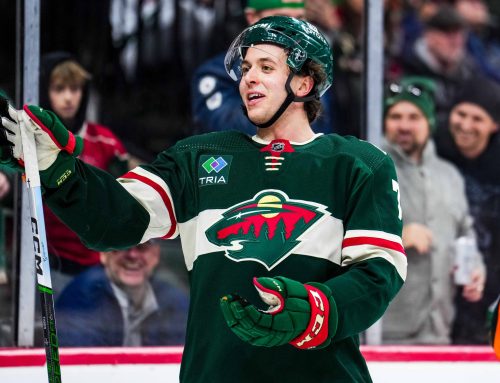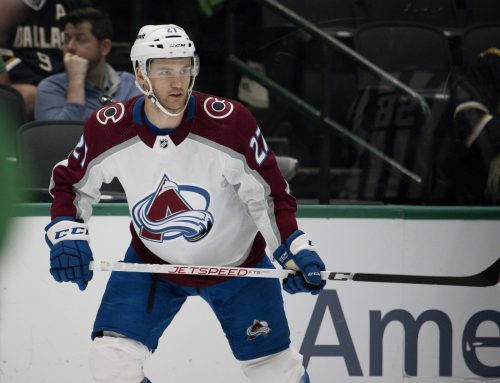
Welcome back to another installment of “Goldipucks and the Three Skaters.” For first time readers, or those needing a refresher, this column is a play on the Goldilocks and the Three Bears story, except instead of there being three bowls of porridge I’m covering three skaters and declaring one too hot (i.e., doing unsustainably better than he should), another too cold (i.e., doing unsustainably worse), and a third “just right” (i.e., producing where he should be). I also assign each a 1-10 rating, indicating just how hot (rated 7-10, where 10 is the most unsustainably hot), how cold (rated 1-4, where 1 is the most unsustainably cold), or how “just right” (rated 4-7, where 5.5 is the most “just right”) he is.
This week we’re focusing on three players from teams which didn’t make the Stanley Cup playoffs: Anthony Mantha, Darnell Nurse, and Jakub Voracek. Can you guess who was too hot, who was too cold, and who was “just right” for 2018-19? Give it a shot then see if you’re correct after you read on.
Anthony Mantha
At first glance it appears Mantha was stuck in neutral for 2018-19, posting his second consecutive 48 point output on an identical 12.6% personal shooting percentage. However, whereas in 2017-18 those 48 points came in 80 games this time around it only took him 67 contests to reach the total, translating to a 58 point full season pace. Is the real Mantha what we saw this season, or did he overachieve? The answer is neither – we should expect him to do even better in 2019-20 and beyond.
It turns out Mantha has still more hidden production, as 33 of his 48 points came in his final 38 games. So if we go by his second half, he was scoring at a 71 point full season rate. Moreover, although his ice time wasn’t increasing while that was occurring, he was shooting the puck more – an average of 3.15 SOG per game, which was half a shot better than his first half rate and 0.8 SOG per game better than what it was in 2017-18. And yet as noted above his personal shooting percentage remained at 12.6%. Thus, the takeaway is he was dialled into the offence more as 2018-19 wore on, which should carry through to 2019-20, especially considering it’ll be his “magical fourth year.”
Mantha’s main luck metrics for 2018-19 also were encouraging overall. His IPP (i.e., percentage of points he received on goals scored while he was on the ice) was 69.6% this season, up slightly from 2017-18; and he saw his scoring improve despite his 5v5 team shooting percentage dropping to 6.9%. His offensive zone starting percentage also rose to a career high of 58%, which leaves room for further growth and also is only a moderate increase from past seasons, therefore not calling into question his production level.
Also encouraging is the fact that Mantha essentially equaled his two-to-one primary to secondary assists ratio of last season (16 vs. 8) during the 2018-19 season (15 vs. 8). So Mantha didn’t luck into extra points via assists that he won’t be able to get again, and there’s still room for more organic assists to come as his game matures. Another key is although Mantha finished with an average TOI of 17:50 per game and took the ice for 52.3% of Detroit’s man-advantage time, he had 19:00+ per game and took the ice for a higher percentage of man-advantage time in eight of his last 12 contests for 2018-19. This not only helps to legitimize his higher scoring during that time period but also bodes well for his ice times to stay that high come next season.
All things considered, and factoring in his second-half trends, Mantha’s 2018-19 total is TOO COLD. With his magical fourth year upcoming and him nearing the age when most “big men” truly figure out their games, chances are he’ll produce closer to his second-half numbers and be at 70+ points next season. So I’m assigning him a rating of 2.25, for a healthy jump in scoring from his full-season pace of 58 points.
Darnell Nurse
It was indeed a “magical fourth year” for Nurse, who saw his scoring increase from 2017-18 by over 50 percent in posting a point per every other game. What does the future hold for Nurse? Sadly for poolies who own him, probably not many (if any) more seasons of 40+ point production.
Whereas Mantha’s season-long totals obscured how scorching hot he was in the second half, Nurse’s cover up just how much he benefitted from the absence of Oscar Klefbom for 21 games. Need proof? Nurse’s scoring rate was, as noted above, a point per every other game and his season-long PP Time per game was 1:51. In the 21 contests Klefbom missed, however, Nurse tallied 16 points and also had 16 games in which he received at least 2:30 of PP Time, compared to nine such games of 2:30+ of man advantage time and 25 points in his other 61 contests.
Also, despite averaging 1:34 per game more in TOI for 2018-19 as compared to last season, Nurse’s SOG total was almost unchanged (196 in 82 games this season, versus 194 in 82 games in 2017-18). Although that is an excellent SOG rate (placing him 8th among the 30 d-men who tallied 40+ points in 2018-19), the fact that it didn’t increase and still only led to him getting 41 points despite Klefbom missing 25% of the season isn’t encouraging in terms of him being able to reach the 40 point mark again once Klefbom is back in the fold for an entire campaign.
Although Nurse’s IPP did rise to 39.6% for 2018-19, that too may have been a function of his production while Klefbom was out of the line-up. Come next season, it should return to the 32-35% it was in his prior two campaigns. Moreover, although he averaged 1:51 per game with the man advantage, up from 0:29 last season and his shorthanded deployment dropped from taking the ice for 45.4% of Edmonton’s PK minutes to only 39%, his offensive zone starting percentage still fell for the second straight season, this time to 45.6%. Clearly, the Oilers still see Nurse as a shutdown d-man, which won’t help his scoring in future seasons.
Based on the totality of circumstances and beneath the surface data, Nurse’s fantasy value has not changed much from what it was when he was a 26 point defenseman in 2017-18. Yes, he showed he can step up and produce if given the chance to do so; however, even after Nurse shined while Klefbom was hurt, once Klefbom was back in the line-up Nurse’s PP Time and scoring dried up, so we’re left with the takeaway that the team values Nurse more for his shutdown skills than for putting points on the scoreboard. And as we know all too well, opportunity has a greater influence than talent when it comes to fantasy output.
For these reasons, Nurse was TOO HOT in 2018-19 and should see his scoring dip down to roughly 30 to 35 points next season. Thus he gets a rating of 8.5.
Jakub Voracek
Coming off a career-high 85 points in 2017-18, much was expected of Voracek. But he dipped to 66 points in 78 games. Was this a function of the struggles of the team around him, meaning we should expect him to rebound? Not from where I sit; instead, this looks like, at best, his new normal.
For the past five seasons, Voracek’s per game ice time average has varied by no more than 30 seconds (18:35 to 19:14; 18:40 this season) and his PP TOI per game average by only 20 seconds (3:15 to 3:36; 3:15 this season). Yet his point totals have been polarized, with two campaigns of 80+ points but also three where his 82 game scoring rate was between 60 and 70 points and none of 70-80 points.
How does that make sense? The answer is PP scoring, as in his two seasons of 80+ points Voracek had 33 and 35 PPPts, whereas in the other three seasons he had 23, 23 and, for 2018-19, just 18. The issue is, in the past we could envision the Flyer power play rebounding; but between the team’s aging core and new head coach Alain Vigneault’s track record when he coached the Rangers (New York never being in the league top ten in PP conversion percentage while he was their coach), that might be a stretch.
Another key about Vigneault is he doesn’t like to lean on his stars, as not once in his five seasons in New York did any forward average 19:00 per game; and other than Brad Richards way back in 2013-14, none saw 3:00+ of man-advantage time per game. Therefore, while Voracek could see his overall TOI remain similar, he’s due for a cut in PP Time even from his five year low of last season, making it even less likely for his PPPts to rebound to the levels they apparently need to be for him to score 80+ points.
We also have to consider that Voracek might be slowing down. He’ll turn 30 before the puck drops on the 2019-20 campaign, and his SOG total for 2018-19 was his lowest since 2011-12. One silver lining may be that less shooting translates to higher quality shots, as his personal shooting percentage was 9.5%, for his highest percentage since 2014-15 and his average shot distance of 26.2 feet was the first time it’d been below 31.5 feet dating back to 2011-12. So overall, his fewer SOG, while not ideal, also might not foreshadow a further drop in scoring.
As for Voracek’s luck metrics, they’re a mix of highs, lows, and middle ground. While his offensive zone starting percentage of 47.6% was a low for him during his Flyer’s tenure, his 8.28% 5×5 team shooting percentage was the second highest it’s been since 2013-14. And his 69.6% IPP was just above his 68.9% average over the past six seasons. Also interesting is that Voracek’s recent points per 60 minutes had either been high (3.2 in his 80+ point seasons) or low (2.3 and 2.4 in the two campaigns between his 80 point campaigns). This season it was 2.7, so perhaps his days of high or low P/60 rates are over and he’ll now be nearer to a middle ground?
Voracek is a fine player, but he’s not a point per game scorer, as the only two times he reached that threshold he had PPPts that were abnormally high. What’s more, with the Flyers PP likely to be – if anything – less potent next year with Alain Vigneault at the helm, it’s not realistic to count on Voracek’s PPPts (or, in turn, his overall production) rebounding. Thus, Voracek was JUST RIGHT for 2018-19, and he gets a rating of 6, to signify that he’ll likely be closer to 65 points instead of his 69 point pace from 2018-19 due to these factors plus advancing age and declining SOG totals.
****
Mailbag questions needed
I’m always in need of questions about fantasy hockey for me to answer in my monthly mailbag column. There are two ways for you to get your questions to me – (1) email it to admin@dobbersports.com with “Roos Mailbag” in the subject line, or (2) send me a private message at the DobberHockey Forums with your question (my username is “rizzeedizzee”.





 WSH
WSH CAR
CAR WPG
WPG DAL
DAL TOR
TOR DET
DET MIN
MIN EDM
EDM VGK
VGK FLA
FLA
